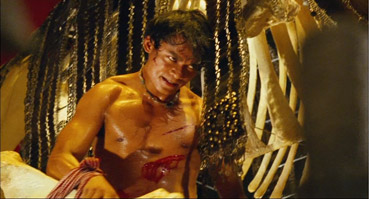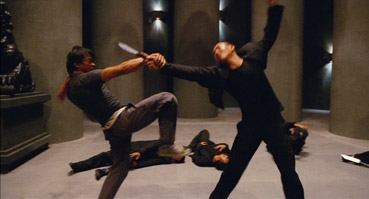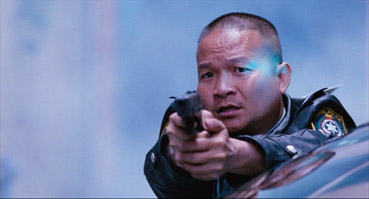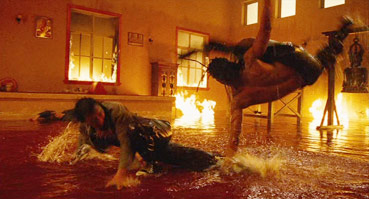|
Site
regulars, if such animals actually exist, will know that there's
one genre I simply can't be objective about, and that's
martial arts cinema. I grew up with these movies, a cinematic
rite of passage for a young teenager taking his first underage
toe dip into the world of adult action cinema. It's a love
affair I never got over, and to this day will still forgive
the simplistic plotting and characterisations the genre
seems to specialise in to get to a few stonking good fight
sequences.
In
2003 a new star arrived on the martial arts scene with a
very big bang. Tony Jaa not only hailed from Thailand rather
than Hong Kong, but introduced the film-going public to
Muay Thai, a martial art of wincing brutality in which
elbows and knees are as viable as weapons as fists and feet.
It was a film that starkly separated the martial arts cinema
fans from the general movie-going public – while the former
(myself included) were enthusing about Jaa's fighting and
athletic skills, the film's rejection of CGI and wire
work and stunt doubles to deliver action sequences that genuinely
made your eyes bulge, the latter were complaining that the
story was a bit weak. Whenever I hear that I wonder just
how many kung-fu films these people have seen. Bloody hell,
almost none of them have great stories. In martial arts
cinema the law of binary opposition rules the roost – it's good verses
evil and the plot functions only to move you from one action
sequence to the next. In this genre, the fight scenes really
are the film's one and only raison d'être.
And on that score, Ong-Bak
did just about everything right.

A
lot was riding on the follow-up film, whatever form it might
take, and news that Jaa was once again working with director
Prachya Pinkaew certainly upped the stakes. Even before
it arrived it was a foregone conclusion that the film would once
again divide the audience, and advance critical reaction
only served to confirm this. Now it's here, on DVD, and
I can state categorically that if you had issues with Ong-Bak
because of the storyline then you're going to have exactly
the same problems here. But if you were thrilled
in any way by Jaa's auspicious career-launcher, then the
chances are you're going to find plenty to get excited about
in Tom yum goong, as as it's been titled for western audiences,
Warrior King.
Having
said all that, I have to admit that the unadventurous plotting here is likely to prompt even hardened genre fans to let out a small groan of recognition. In Ong-Bak
Jaa played Ting, a simple and spiritual country boy who
is so angry when the head of the temple Buddha is stolen
that he chases the bad guys to the big city, where he meets
up with luckless hustler George, played partly for laughs
by Petchtai Wongkamlao. In Warrior King
Jaa plays Kham, a simple and spiritual country boy who is
so distraught when his elephants are stolen that he chases
the bad guys to the big city, where he meets up with luckless
cop Mark, played partly for laughs by Petchtai Wongkamlao.
I know I said the plot wasn't that important in martial
arts films, but they could have at least tried
to come up with something new. OK we're in Australia rather
than Thailand but this is surface detail, especially given
that most of the action takes place in Sydney's Thai community,
though it does make it easier to drop foreign bad guys into
the story without having to explain how they arrived on
the scene. It takes some time to get there, though, due
to an extended opening in which Jaa grows up with the elephants
as friends in the serenely beautiful and handsomely photographed
Thai countryside. But once we're in the city...
If
you've seen Ong-Bak (and you should have
by now) then you'll already be aware that in this new breed
of Thai martial arts film, when people get hit, it hurts.
And there's no "wait-for-it" tease this time around
– just minutes after the elephants are whisked away, Jaa
explodes into a club full of bad guys and introduces them
to a world of serious pain. It's here that we get a full
taste of things to come, both good and not-so-good. The
bigger budget allows Wongkamlao to follow this fight with
a high-speed boat chase, complete with spectacular crashes
and comic asides, but it's impact is lessened by a relentlessly
waggly camera and frantic over-editing – James Bond this
is not. We also get our first glimpse of a visual tick that
I, for one, find incredibly irritating, a sort of variable
focus filter that throws part of the picture into blur in
the manner of a music video visual (or an old, vaseline
lens wedding photo). It's employed here randomly but with infuriating regularity – at one point every
fifth shot seemed so afflicted.

From
this point on the balance of elements is much as expected, a little bit
of plot followed by a burst of action, and here's where
the film comes into its own, though once again the path
is not a consistently smooth one. A Jackie Chan-style battle
against drug dealers, BMX bandits and fluorescent tube wielding
rollerbladers, for example, suffers a little at the hands
of less-than-ideal camera angles, machine-gun editing, and
a drifting stedicam that struggles to keep up with Jaa as he
leaps and darts in and out of parked tram cars. And if this
were the only major action scene in the film, then Warrior
King might indeed have a problem. But it ain't, not by a long shot.
There
were three times during Warrior King when
my jaw hit the floor. The most visually splendiferous is
a fight in a burning church that plays almost like a demo
for a high definition version of the video game Tekken, as
Jaa goes up against Eddie Gordo, an armour-free Yoshimitsu
and a hulking Craig Marduk ("I'll break your face!"),
but all of this is for real and, as ever, effects and wire-work
free. The Eddie Gordo stand-in in particular is a dazzler,
his Brazilian Capoeira fighting style a whirl of spinning
limbs and gymnastics, though the sheer size of Marduk in
comparison to the diminutive Jaa looks almost like the result of Lord
of the Rings style CGI trickery.
Altogether
nastier is a climactic battle against a veritable army of
black-clad warriors, a fight almost absurd in scale that
is nonetheless probably the single most violent hand-to-hand
combat I have ever witnessed. Jaa doesn't simply punch and
kick here, he breaks arms, legs and necks, and twists limbs
out of shape to some of the most horrible sound effects
I have heard in a martial arts film. And it goes on
for ages. Imagine the sequence in Kurosawa's Red
Beard where Toshiro Mifune's doctor loses his rag
and uses his knowledge of anatomy to incapacitate a rowdy
gang and multiply it by twenty. Even I found myself mid-way through thinking "Enough! You've won! Leave them
alone!" It's still a bravura piece of choreography,
but a genuinely wince-inducing one.
But
the real show-stopper, the sequence that every fan of martial
arts cinema should see the film for, has Jaa make his way through a large,
three-storey, criminal-run club/restaurant and fight a total
of 30 opponents (I counted 'em), smashing their heads into
windows, throwing them through wooden screens, assaulting
them with furniture, and even picking them up and hurling
him off the balcony into a display two storeys below, and
it's all done in one, 3 minute 46 second stedicam shot.
The planning, timing and stamina required to pull this off
are just mind-bending, but pull it off they do. It's a
stunning marriage of fight choreography, stunt work and
camera direction that actually has a dramatic pay-off when
Kham discovers just what is located on the top floor, as
darkly and inventively twisted an idea as you'll find in
a film all year, and all the more disturbing because it
very probably exists.

So
yes, the story is flimsy, but Warrior King
delivers where it counts and is an absolute must-see for
all genre fans. Jaa confirms his status as the most exciting
screen fighter around today, and if he could just drop the
MTV visuals and editing and get himself a decent script,
then director Petchtai Wongkamlao could yet climb to the
very top of the action tree.
1.85:1
and anamorphically enhanced, the picture quality does vary
a little, with grain far more noticeable in some scenes
than others, though this appears to be very much down to
the lighting conditions and the stock used – there was certainly
no way to light the four minute take at normal movie brightness
levels given the ground covered, resulting in a film speed
shift for that and similar sequences. Elsewhere the picture
is very impressive, notably the opening sequences in Thailand
with the elephants, where colour, contrast and detail levels
are first rate.
Thai
5.1 and DTS tracks are available and both are first rate,
with very specific use of surrounds and a splendid dynamic
range. The DTS track is noticeably louder than the 5.1 and
has considerably more oomph in the action sequences, especially
when the LFE bass kicks in.
Promotional
Gallery
In
here you'll find the Original Theatrical Teaser
(1:07), two Original Theatrical Trailers
(2:07 and 2:39), the UK Theatrical Teaser
(0:57), and the UK Theatrical Trailer
(1:00). If trailers are your thing, there's certainly enough
variety here to keep you happy.
Also
here is On the Press Trail (12:28),
which consists of Jaa showing his stuff at various international
press conferences, fight demonstrations and screenings,
inexplicably set to music that largely drowns out the live
sound. It's still seriously neat to watch the stunts being
done live without camera and editing trickery. Jaa's genre
superstar status is clearly evident here.

Interview
Gallery
First
up it's Tony Jaa (27:38) himself,
who talks about his schooling in martial arts, his respect
for the film fighters that inspired him, his determination
to make a specifically Thai martial arts film, and the fight
preparation and choreography of specific scenes, including
the four minute show-stopper. He reveals here the importance
of elephants to his own background – he grew up with them
around and his family still own two – and talks about the
mixture of violence and grace that is Muay Thai and the
importance of making a film that would reach an international
audience. And if you're wondering how Jaa stays so fit,
it's down to eight hours of exercise a day...
Petchtai
Wongkamlao (14:35) talks about his early career
as a stand-up comedian and his gradual switch to film acting,
his struggles with the English language (which he has to
speak in the film), and working with Jaa and director Pinkaew,
whose quiet voice he takes the piss out of and whose physical
appearance he suggests makes him look more a supermarket
butcher than an action movie director. He also reveals that
he's a big fan of Rowan Atkinson and David Beckham, to whom
he claims to have a strong physical resemblance. This is
a lively and entertaining interview that nicely showcases
Wongkamlao's cheery personality.
Bongkoj
Khongmalai (4:35) briefly talks about playing
the token female role of Pla in the film and working with
director Pinkaew.
Director
Prachya Pinkaew (14:57) discusses the production
of Warrior King and the problems associated
with following up a success like Ong-Bak,
and the importance of elephants to the Thai people. He also
discusses the shooting of individual scenes, including the
four-minute take.
Stunt
Co-Ordinator Panna Rittikarai (10:36) covers
expected ground, but in interesting detail, especially when
discussing working with Jaa. Inevitably the four minute
take gets covered.
All
of the interviews are in Thai with optional English subtitles.
A
Warrior's Journey
Revolution
Uprising: Pre-Production Action (13:46) begins
with an announcement about the image quality, as this was
shot on what looks like mini-DV during the rehearsals and
there is a small amount of image break-up in places. It
consists of fight sequence rehearsal footage that has been
shot and edited as a sort of training run for the movie
proper. It has also had music and the same punch noise for
most of the hits added, though not, I suspect, by the Warrior
King crew. Good stuff, nonetheless.
A
Different Line: Multi-Angle Sequence (17:06)
has several action scenes play side-by-side with an alternative
cut of the same, using slightly different camera angles
and cutting. Occasionally the alternative version is actually
preferable, sometimes the reverse, but usually there's little
in it.
Making
the Warrior: Cast and Crew Interviews (9:45)
was shot on location in Australia during the production
and focuses on the English-speaking cast and crew members.
The
film's weaknesses are plain to see, but so are its very
considerable strengths. My advice is to forget the plot
and go for the action and you will not be disappointed –
Warrior King boasts some of the most startling,
acrobatic and wincingly violent fight sequences you'll see
all year. Despite some stiff competition from the boys in
District 13,
Jaa is still the present martial arts movie king.
Premiere
Asia's 2-disc release may lack Ong-Bak's
enjoyable and informative commentary (by guess who), but
in every other respect it delivers the goods. Warts and
all, Warrior King comes brutally recommended.
|